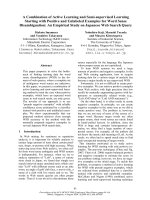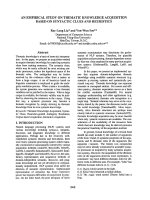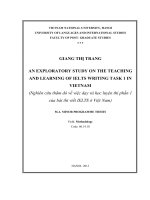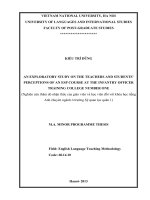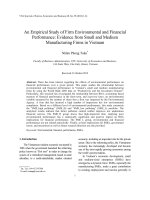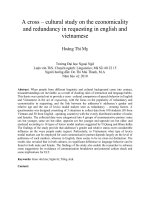An empirical study on functional diversity and innovation in SMEs
Bạn đang xem bản rút gọn của tài liệu. Xem và tải ngay bản đầy đủ của tài liệu tại đây (479.84 KB, 128 trang )
An empirical study on functional diversity
and innovation in SMEs
Patrick Lemaire
A THESIS SUBMITTED
FOR THE DEGREE OF MASTER OF ENGINEERING
DEPARTMENT INDUSTRIAL AND SYSTEMS ENGINEERING
NATIONAL UNIVERSITY OF SINGAPORE
2003
Acknowledgements
I would like to thank Dr Chai Kah Hin and Dr Yap Chee Meng my supervisor and cosupervisor for their guidance and support throughout this research.
I would also like to thank my lab mates and the members of the ISE department in
general. In particular I would like to thank Frédéric Granel, Tan Yen Ping, Tao Zhen,
Xin Yan for their assistance during the sending of the questionnaires.
I would also like to thank my friends in Singapore with whom I shared this great
experience. They played a great role in making this stay abroad unforgettable and their
constant support and advices helped me to deal with this project.
Finally I am grateful to the National University of Singapore whose financial support
was essential to the completion of this project.
i
Table of contents
ACKNOWLEDGEMENTS ................................................................................. I
TABLE OF CONTENTS................................................................................... II
SUMMARY...................................................................................................... IV
LIST OF FIGURES.......................................................................................... VI
LIST OF TABLES .......................................................................................... VII
CHAPTER 1
INTRODUCTION ..................................................................... 1
1.1
Research background ............................................................................................................... 1
1.2
Research objectives ................................................................................................................... 2
1.3
Thesis structure ......................................................................................................................... 3
CHAPTER 2
2.1
LITERATURE REVIEW........................................................... 6
Introduction ............................................................................................................................... 6
2.2
Innovation .................................................................................................................................. 6
2.2.1
Definition................................................................................................................................ 6
2.2.2
Models of innovation process................................................................................................. 8
2.2.3
Factors driving innovation in organizations ......................................................................... 10
2.3
Resource-based view and innovation..................................................................................... 13
2.3.1
Resource-based view ............................................................................................................ 13
2.3.2
Knowledge-based view ........................................................................................................ 14
2.4
Small and Medium Enterprises (SME) and innovation....................................................... 18
2.4.1
Management role in Small and Medium Enterprises (SME)................................................ 18
2.4.2
Innovative process in Small and Medium Enterprises (SME).............................................. 18
2.4.3
Resources in Small and Medium Enterprises (SME) ........................................................... 19
2.5
Skills and knowledge diversity ............................................................................................... 20
2.5.1
General skilled-based diversity ............................................................................................ 20
2.5.2
Functional diversity .............................................................................................................. 21
2.5.3
Human resources in Small and Medium Enterprises (SME) ................................................ 24
2.6
Conclusion and research questions........................................................................................ 25
CHAPTER 3
3.1
THEORY AND HYPOTHESIS................................................27
Introduction ............................................................................................................................. 27
3.2
Functional diversity and innovation ...................................................................................... 27
3.2.1
Size as moderator ................................................................................................................. 32
3.2.2
Growth as moderator ............................................................................................................ 34
3.3
Conclusion................................................................................................................................ 37
CHAPTER 4
4.1
DEVELOPMENT OF THE SURVEY INSTRUMENT ..............38
Introduction ............................................................................................................................. 38
4.2
Measures .................................................................................................................................. 38
4.2.1
Dependent variable............................................................................................................... 38
4.2.2
Independent variables........................................................................................................... 40
4.2.3
Moderator variables.............................................................................................................. 45
4.2.4
Control variables .................................................................................................................. 46
4.2.5
Limitations............................................................................................................................ 49
4.3
Testing of the survey instrument ........................................................................................... 50
ii
4.4
Surveyed population ............................................................................................................... 50
4.5
Survey implementation ........................................................................................................... 52
4.6
Conclusion................................................................................................................................ 53
CHAPTER 5
5.1
DATA ANALYSIS AND DISCUSSION ..................................54
Introduction ............................................................................................................................. 54
5.2
Preliminary analysis................................................................................................................ 54
5.2.1
Number of responses ............................................................................................................ 54
5.2.2
Characteristics of respondents and profile of firms .............................................................. 56
5.2.3
Non-respondent bias test ...................................................................................................... 58
5.2.4
Scales analysis ...................................................................................................................... 59
5.2.5
Test of normality, multicollinearity, constant variance. ....................................................... 64
5.2.6
Descriptive statistics ............................................................................................................. 66
5.3
Multiple regression analysis ................................................................................................... 68
5.3.1
Functional diversities and innovative performance .............................................................. 68
5.3.2
Test of the moderators on intrapersonal functional diversity ............................................... 69
5.3.3
Test of the moderators on dominant function diversity ........................................................ 73
5.4
Discussion of research findings .............................................................................................. 77
5.5
Conclusion................................................................................................................................ 82
CHAPTER 6
CONCLUSION .......................................................................84
6.1
Introduction ............................................................................................................................. 84
6.2
Research findings .................................................................................................................... 84
6.3
Implication for theory............................................................................................................. 86
6.4
Implication for SMEs’ human resources management........................................................ 87
6.5
Limitations of this research and future directions ............................................................... 88
6.6
Conclusion................................................................................................................................ 90
REFERENCES ................................................................................................92
APPENDIX A ................................................................................................100
APPENDIX B ................................................................................................105
APPENDIX C ................................................................................................114
iii
Summary
This thesis examines the research problem of the impact of functional diversity on
innovation. Functional diversity within a group can be found either in the
specialization of each individual (dominant function diversity) or in the range of
functions that each individual can handle (intrapersonal functional diversity). A review
of the literature suggests that functional diversity can foster innovation but no
comprehensive empirical study has been carried out to understand the effective impact
of each concept. In addition, the human resources characteristics of the firm have
barely been considered as an important factor affecting the impact of functional
diversity on innovation.
The argument advanced herein suggests that functional diversity within the
management staff of small and medium enterprises has a positive impact on innovation
but, different concepts of functional diversity must be considered depending on the
size and the growth of the company. Two issues are of concern in this thesis: first, do
different concepts of functional diversity have different impact on innovation? Second,
under what circumstances should one concept or the other be taken into account to
foster innovation in a company? The research focuses on two different concepts of
functional diversity used in the literature, intrapersonal functional diversity and
dominant function diversity. Their respective impact on the innovation process is
tested empirically with data drawn from mailed questionnaires. Statistical analyses are
conducted to study the evolution of the effect of these two types of functional diversity
on innovation according to the human resources size and the growth of the firm. The
iv
relevance of these concepts for small and medium enterprises is discussed according to
their size and their growth.
The foundation of the research process is a two phase research methodology: (i)
literature based development of survey instrument for measuring functional diversity
and innovation performance; (ii) large sample survey of 500 SMEs in Singapore.
Survey findings suggest that (i) intrapersonal functional diversity of the management
staff has a positive impact on the firm’s innovative performance; (ii) the smaller the
firm is, the stronger is the impact of intrapersonal functional diversity on innovation;
(iii) dominant function diversity has no significant impact on innovation; (iv) in a staff
reduction environment firms should focus on intrapersonal functional diversity of the
management staff in order to foster innovation.
v
List of Figures
Figure 2-1 The process based model of innovation Source: Chiesa et al. (1996) ........ 12
Figure 4-1 Two different distributions for the dominant function diversity................. 44
Figure 4-2 Number of questionnaire sent ..................................................................... 52
Figure 5-1 Test of homoscedasticity............................................................................. 65
Figure 5-2 Three different impact of intrapersonal diversity on innovation,
depending on the size ................................................................................... 71
Figure 5-3 Evolution of the slope coefficient of intrapersonal functional diversity
with the size of the firm ............................................................................... 72
Figure 5-4 Three different impact of dominant function diversity on innovation,
depending on the growth.............................................................................. 75
Figure 5-5 Evolution of the slope coefficient of dominant function diversity with
the growth of the firm .................................................................................. 76
Figure 5-6 Evolution of the slope coefficient of the functional diversity effect
with the growth rate ..................................................................................... 81
vi
List of Tables
Table 4-1 Functional background of two groups of employees ................................... 43
Table 4-2 Dominant function diversity for two different groups and two different
distributions.................................................................................................. 44
Table 5-1 Response at the firm level ............................................................................ 54
Table 5-2 Response at the employee level.................................................................... 55
Table 5-3 Seniority of the respondents ......................................................................... 56
Table 5-4 Length of service of the respondents............................................................ 57
Table 5-5 Nature of business ........................................................................................ 57
Table 5-6 Nature of business ........................................................................................ 58
Table 5-7 Non-response bias test.................................................................................. 59
Table 5-8 Item-total Statistics for CUL construct......................................................... 60
Table 5-9 Item-total Statistics for ICT construct .......................................................... 60
Table 5-10 CUL construct components matrix............................................................. 61
Table 5-11 ICT construct component matrix................................................................ 61
Table 5-12 Total Variance Explained for CUL construct............................................. 62
Table 5-13 CUL construct component matrix .............................................................. 62
Table 5-14 Communality statistics for CUL construct ................................................. 63
Table 5-15 Communality statistics for ICT construct................................................... 63
Table 5-16 Internal consistency test ............................................................................. 63
Table 5-17 Test of Normality ....................................................................................... 64
Table 5-18 Test of multicollinearity ............................................................................. 66
Table 5-19 Descriptive statistics, Cronbach alphas and correlation coefficients ......... 67
Table 5-20 Functional diversity as predictor ................................................................ 69
Table 5-21 Result of Moderated Regression Analysis of intrapersonal functional
diversity variable, Size, Growth, and Innovation......................................... 73
Table 5-22 Result of moderated regression analysis of dominant function
diversity variable, size, growth, and innovation .......................................... 77
Table 5-23 Multiple regression analysis including growth as moderator of both
types of functional diversity......................................................................... 80
Table 6-1 Research findings summary ......................................................................... 86
vii
Chapter 1 Introduction
Chapter 1
Introduction
1.1 Research background
Small and Medium Enterprises are main actors in a country’s economy. Their growth
and development have a direct impact on the economic quality of life (Morris and
Lewis, 1991). SMEs play a key role in generating employment, promoting innovation,
engendering competition, and creating economic wealth (Sengenberger et al., 1990).
Thus, the Singaporean government is granting them more and more importance (Tan,
2002). Moreover, innovative firms explain a substantial part of the growth of a nation
which can only be sustained by a continuous development of new products and
industries. Innovation will play an increasingly important role in the developed
countries’ future growth.
At firm level, the search for competitive advantage has led to the recognition of
innovation as a vital ingredient for survival and profitability (Tidd et al.1997;
Lumpking and Dess, 1996; Read 2000). Firms compete with the introduction of new
product or services, to capture new markets and to reach the fast changing customers’
expectations. They also seek new processes for production and service delivery to
reduce costs and increase the customers’ satisfaction.
The management of innovation can be studied through the action taken by the
management to improve the firm’s innovative performance (Leonard-Barton, 1995).
Managers play an important role in building and exploiting unique resources and
capabilities. The resource-based view focuses on these unique resources which are
1
Chapter 1 Introduction
essential for the firm performance and thus give the firm substantial competitive
advantages (Penrose, 1995; Barney, 1991).
This thesis focuses on the human resources as part of the set of resources that the
managers have to develop and manage. The ability of a firm to innovate and improve
continuously has been proven to be related to the employees’ skills and knowledge
(Nonaka and Kenny, 1991; Nonaka, 1991). The employees’ skill sets and experiences
must be adapted to the firm and it takes years to build up this intangible asset
efficiently (Heneman et al., 2000). The intrinsic specificity of SMEs is their human
resources limitation. Obviously, they can not encompass all the skills required to fulfill
all the functionalities, which compels them to enhance and focus on specific ones
while outsourcing others. Empirical studies have shown that functionally diverse teams
can be more innovative (Bantel and Jackson, 1989). Functional diversity can be
conceptualized as the distribution of team members across a range of relevant
functional categories. However, it can also be found in individuals with experiences in
a broad range of functional areas. These two different types of functional diversity may
have a different impact on innovation. Moreover, in a limited human resources
environment, SMEs may not be able to generate diversity through narrow functional
specialist spread across all the functions required. Intrapersonal diversity might be a
solution to this lack of resources.
1.2 Research objectives
This study aims at identifying the impact of functional diversity on innovation. In
order to tackle SMEs’ lack of human resources, we will consider both functional
diversity between employees and diversity of each employee. We will try to
2
Chapter 1 Introduction
understand their respective impact on innovation. This study will focus on the
managerial staff and the main role it has on the innovative process. This research aims
to specify the type of diversity that SME should seek according to their human
resources size and growth. This study will therefore follow two research questions.
♦
In SMEs, what is the effect of dominant function and intrapersonal
functional diversity of the managerial staff on innovation?
♦
In SMEs, which functional diversity should be sought among the
managerial staff in order to foster innovation?
We shall review previous studies which have been done in the human resources
functional diversity field. This analysis will enable us to establish some hypothesis on
the impact of dominant function and intrapersonal functional diversity on innovation.
Literature on size and growth of SMEs will highlight the issues they face to be
innovative. Accordingly, we will draw some hypothesis on the human resources
diversity management that SMEs should adopt to be innovative. These hypotheses will
be tested through a survey carried out among Singaporean’s SME.
With regard to theory, this thesis contributes to knowledge by testing empirically the
effect of diverse concepts of functional diversity on innovation performance of a firm.
In practice, the results of the study will help SMEs to build up their human resources in
order to be more innovative.
1.3 Thesis structure
The following figure shows the organization of the thesis and the following paragraphs
give an overview of each chapter.
3
Chapter 1 Introduction
In Chapter 2, we review the literature related to the research. We introduce the concept
of innovation and some of the models which enables to deal with it. We then highlight
the characteristics of innovative firms, from a general prospective to the resource based
view before focusing on human resources. We review the work done on the impact of
functional background diversity which leads us to the research questions of this thesis.
The Chapter 3 deals with the elaboration of the theory and the hypothesis. We
introduce two concepts of functional background diversity, the intrapersonal functional
and the dominant function diversity which we relate to the innovative performance in
two hypotheses. We introduce the size and the growth of the firm as moderators in the
relationships between innovation and functional diversity.
The Chapter 4 details the development of the survey instrument including a section on
pre-testing. This instrument enables us to collect the data required for the hypotheses
testing.
In the Chapter 5, one can find the statistical analysis of the survey. In this chapter we
describe in detail the variables which are used to analyze the data; we conduct
preliminary analysis on the dataset before achieving the multiple regression analysis.
In discussing the results, we evaluate the extent in which the research questions have
been adequately answered in the context of extend literature.
We conclude this thesis with a last chapter, recalling succinctly the key findings in the
research. In the light of the findings, we detail the implication for theory and for the
4
Chapter 1 Introduction
human resource practices in SMEs. Finally, based on the research limitation identified,
we propose the main areas for future researches.
5
Chapter 2 Literature review
Chapter 2
Literature review
2.1 Introduction
This chapter provides an overview of previous work in areas related to our research
topic. Firstly, we introduce innovation, the main concepts used to describe it and the
factors which have an impact on innovation at the firm level. We then approach
innovation from a resource-based view before stating the small and medium
enterprises specificities with regard to innovation. The fifth section describes the
concepts of diversity used to establish the theory of this research. Finally we present
our research questions based on the gaps identified.
2.2 Innovation
Innovation is a vague concept which needs to be defined in order to set the frame of
this study. The following paragraph reviews the definitions used in the literature and
highlights the one relevant to our study.
2.2.1 Definition
There are many definitions of innovation in the literature. It varies according to the
types of innovation and the level of analysis which is used (Garcia and Calantone,
2002; Read, 2000). Generally speaking, the term ‘innovation’ is used to denote an idea,
product, process, system or device that is perceived as new to an individual, group of
people, organization, industrial sector or a society as a whole (Rogers, 1995; Freeman,
6
Chapter 2 Literature review
1997). Innovation is often confused with invention. “An invention is an idea, a sketch
or model for a new or improved device, product, process or system whereas an
innovation in the economic sense is accomplished only with the first commercial
transaction involving the new product, process, system or device…” (Freeman, 1997).
West and Farr (1990) define innovation as “the intentional introduction and application
within a role, group or organization of ideas, processes, products or procedures, new to
the relevant unit of adoption, designed to significantly benefit the individual, the group,
organization or wider society”. Innovation is a multifunctional process comprising
generation of ideas, development and implementation. Byrd and Brown (2003) define
innovation as the act of introducing something new, the combination of creativity and
risk taking. Gopalakrishnan and Damanpour (1997) highlight three most frequently
used types of innovation: product versus processes, radical versus incremental, and
technical versus administrative. Product innovations refer to the organization’s
introduction of products or services into the market. A process innovation involves the
manufacturing or distribution processes and assists to produce products or services
(outputs) from inputs. According to the degree of change required to implement it, the
innovation can be described as incremental to radical (Cooper, 2001). Garcia and
Calantone (2002) reviewed the innovativeness terminology and classified the degree of
innovativeness of innovations as radical (new technology and new market at the
industry, market or world level), really new (market or technological discontinuity at
the industry, market or world level), and incremental (market and/or technological
discontinuity at the firm or customer level). Finally innovation can be technical or
administrative (Richard, 1978). A technical (or technological) innovation is directly
related to the production of a product or a service whereas an administrative innovation
relates to management oriented processes such as structure, human resource
7
Chapter 2 Literature review
management, and accounting systems. The context in which a new idea, product,
service or activity is implemented determines whether it can be regarded as an
innovation within that specific context.
In our study we will consider both product and process innovations. Product
innovation is considered as the introduction of a new or significantly improved product
or service to the market. A product which has both product and service elements will
be considered as two innovations. Process innovation is considered as the adoption of a
new or significantly improved production or service delivery process for the company.
These adoptions usually lead to improvements in cost reduction, quality improvement,
cycle time reduction etc
We reviewed the various ways innovation is defined in the literature. Their relevance
depends on the context and the level of analysis. Accordingly, different models have
been used to deals with this complex notion. We will review these models to get a
clearer picture of the innovation process.
2.2.2 Models of innovation process
In organizations, innovation is often tackled from a project prospective. The company
aims at the commercialization or the use of a new product, service or process. In the
literature one can find a variety of models which describe the innovative process.
These models have been developed from over-simplified linear models to stage or
process models. Stage models are the most commonly used to study the innovative
process (Read, 2000). They are expanded linear models using a sequence of stages
with clear delimiters, but may also include feedback loops.
8
Chapter 2 Literature review
There are many different types of stage models. Stage models could be sorted into two
main types: the creative problem-solving and the new-product development (Tang,
1998). Almost all the creative problem-solving processes have their roots in the
Osborn-Parnes (Osborn, 1963; Parnes, 1992) model which uses six steps. These are
objective finding, fact finding, problem finding, idea finding, solution finding and
acceptance finding. Each step is subdivided into a divergent thinking phase described
as the development of many possible alternative solutions, and a convergent thinking
phase described as the selection of most promising ideas and plans of action.
The main new product development stage models are the creation and exploitation
(Roberts, 1988), the development funnel (Wheelwright and Clark, 1995), the product
innovation process (Crawford, 2000), and the stage gate process (Cooper, 2001). They
are characterized by sequential stages that are separated by screens or milestones. Even
though the name of stages differs, these models follow a similar succession of steps
which could be grouped into: strategic planning, concept development, design and test,
production and market launch (Padmore et al., 1998; Tang, 1998). The elimination or
consolidation of competing ideas occurs between each stage.
Using these various concepts of innovative process, researchers managed to assess
some critical factors of innovativeness. We will review the main concepts developed in
the literature on innovation factors in the next section.
9
Chapter 2 Literature review
2.2.3 Factors driving innovation in organizations
Four decades of research have generated a robust set of finding on the key factors
driving innovation in organization. The authors mentioned in this section built up
various models explaining the innovative performance of a firm. We can define two
ways in which the literature on innovation has developed, one focusing on the various
determinants on innovation, the other on the innovation process. In this section, we
will first review several determinants at the individual, group and organizational level,
before studying the process models developed in the literature.
At the individual level, several determinants can be highlighted. Brown and Eisenhardt
(1995) focused on the new product development and pointed out the importance of the
different player taking part in the process. The influence of a strong senior
management, the power and the managerial skills of the project leader affect product
development outcome. In his examination of a broad range of organizational
innovation researches, Read (2000) highlights a range of management-oriented
determinants for successful organizational innovation. One of his main findings is that
organizational innovation highly depends on the management support and efforts
towards innovation. It is concluded that innovation is a management process that is
context specific, though the identified determinants for successful innovation are
general principles that all organizations must consider.
At the group level, the cross-functional nature of the project team can positively affect
product development outcome (Brown and Eisenhardt, 1995). In a recent study on
knowledge intensive service, De Jong and Kemp (2003) reviewed and tested the
impact of several determinants on co-worker innovative behavior. They showed a
10
Chapter 2 Literature review
positive impact on innovative behavior for challenge in job, autonomy and external
contacts of the group members.
At the organization level, the strategic orientation of the firm towards innovation and
the differentiation of the market targeted by the company have a positive impact on
innovative behavior (De Jong and Kemp, 2003). Martins and Terblanche (2003)
highlight the importance of an organizational culture promoting creativity and
innovation. The determinants of the organizational culture they considered are the
firm’s strategy, organizational structure, support mechanisms, behavior that
encourages innovation and communication. In his review, Read (2000) highlights that
innovative determinants depend very much on the context of the organization and their
significance varies according to each organization’s unique specificities and
requirements, the customer/market orientation of the firm and the high level of internal
and external communication/networking. Similarly, Rogers (1995) highlighted that the
type, the quality and the quantity of innovation in an organization depend on both its
internal and external environment. Innovations within an organization diffuse into the
external environment and changes in the external environment affect the organization
behavior towards innovation. This approach shows that the process in which an
innovative factor is involve can also affect the innovative outcome.
Another way of studying innovation is therefore to consider the process in which many
innovative factors interact. Tang (1998) proposes a model of innovation in
organization based on six mutually interacting factors affecting innovation:
information and communication, behavior and integration, knowledge and skills,
project raising and doing, guidance and support, and external environment. The author
11
Chapter 2 Literature review
emphasizes the importance of the interaction between all the factors and their
environment. Information and communication will raise issues and problems which
could possibly lead to innovation. The problem solving ability will depend on both
knowledge and skills, and behavior and integration. However, knowledge and skills
status and evolution also depend on the accuracy and efficiency of information and
communication. Guidance and support will have an impact on the project raising and
doing through out the innovative process. Moreover, all these factors are affected and
affect the external environment.
Based on Roberts’ (1988) stage model of innovation and some of the enabling
processes cited above, Chiesa et al. (1996) developed a model of process innovation.
Their core processes are (1) the concept generation, (2) the transfer to manufacturing
through development or process innovation and (3) the technology acquisition. Their
enabling processes are the development of resources, both human and financial, (2) the
use of system and tools, and (3) and the presence of leadership. Through this process,
organization can improve their innovation performance.
Leadership
Process of innovation
Concept
generation
Product
development
Process
innovation
Technology
acquisition
Resourcing
Systems
and Tools
Figure 2-1 The process based model of innovation
Source: Chiesa et al. (1996)
12
Improved
innovation
performance
Chapter 2 Literature review
In this section, we reviewed various models of innovation in organization. The
resource based view model is broadly accepted in the literature to describe the
competitive advantage of an organization. It has been presented as an efficient model
for research on innovativeness in small firms (Hadjimanolis, 2000).
2.3 Resource-based view and innovation
2.3.1 Resource-based view
Within the Economics and Management literature, the resource-based view has been
gaining broad intellectual support among scholars interested in issues related to
sustainable competitive advantage. The resource-based view perspective is useful for
studying innovation for it adopts a dynamic approach that emphasizes importance of
resources accumulation.
The resource-based view has its roots in the work of Edith Penrose “Theory of the
growth of the firm” (1995). The resource-based view of organizations focuses on
resources that can be sources of competitive advantage within the industry. The basic
types of resources providing this competitive advantage are: Physical capital resources,
Organizational capital resources, and Human capital resources (Barney, 1991). The
concept of human capital is that people have skills, experience, and knowledge that
provide economic value to the firm. Barney and Wright (1998) noted that in order for
human capital to contribute to sustainable competitive advantage, it must create value,
remain hard to imitate, and appear rare. Verona (1999) shows the strength of the
resource-based view in dealing with new product development. A resource-based view
13
Chapter 2 Literature review
of product development identifies the knowledge required for successful new product
development, in the different dimensions of functional and integrative capabilities.
Within the resource based view, Miller and Shamsie (1996) distinguished propertybased resources controlled by property rights and knowledge-based resources protected
from imitation by knowledge barriers. The property rights include contracts, deeds of
ownership or patents. The benefits of property-based resources are quite specific and
fixed and thus the resources are adapted for the environment they have been developed
for. The knowledge-based resources is of a greater utility in uncertain changing
environment since it gives firms the skills to adapt their products to market need and to
deal with competitive challenges.
2.3.2 Knowledge-based view
Knowledge-based resources often take the form of particular skills and abilities which
could be technical or social. These unique skills and abilities enable an organization to
cope with new challenges and respond to a larger number of contingencies (Lado and
Wilson, 1994) through innovation. Knowledge is the foundation upon which
innovative ideas are generated (Nonaka and Kenny, 1991; Nonaka, 1991). As noted by
Grant (1996), the real challenge is to access the breadth and depth of knowledge within
a multifunctional team. Hii (1999) describes innovation as a cumulative process of
learning, searching and exploiting. Innovation involves the combination of new and
old ideas resulting in new products, new techniques, new forms of organization and
new markets. Learning is therefore an essential activity for innovation since it enables
the accumulation of knowledge.
14
Chapter 2 Literature review
Learning process
Chapman and Hyland (2003) argue that an essential role of the management should be
to give individuals and groups opportunities to learn, share experiences and innovate
upon this new knowledge. They reviewed the eight behaviors which should be
promoted by the management: priorities improvement and learning activities through
strategic goals; use innovation as opportunities to develop knowledge; use available
resources to experiment with new solutions; integrate knowledge among all different
phases of product innovation; transfer knowledge among different projects; generalize
abstract knowledge for applications; make knowledge available to others; assimilate
and use knowledge from external sources.
In a firm, the learning process is the absorption process of new knowledge which also
encompasses the adaptation to new environment. Cohen and Levinthal (1990) analyze
the ability of the firm to absorb new knowledge from external sources and argue that
the ability to evaluate and utilize external knowledge is largely a function of the level
of prior related knowledge. Interactions among individuals each with a set of
heterogeneous and diverse knowledge structure will enhance the firm’s capacity to
make novel linkages and associations, and therefore to accumulate knowledge (Cohen
and Levinthal, 1990). The overlapping of knowledge enables this interaction among
team members since it facilitates the understanding and communication within the
team (Bunderson and Sutcliffe, 2002; Leonard and Sensiper, 1998).
Argyris and Schön (1978) learning process involves the detection and correction of
error which can be done through single-loop or double-loop learning. Single-loop
learning is the correction of error while keeping the organization current objectives. In
15
Chapter 2 Literature review
double-loop learning, the correction of errors requires the modification of an
organization’s underlying norms, policies and objectives. In this process, the
organization faces discontinuity in its objectives. Firms which strive to be innovative
have to evolve with their dynamic and competitive environment. “Innovativeness is a
measure of discontinuity in the status quo in marketing factors and/or technology
factors” (Garcia and Calantone, 2002). The ability of the firm to cope with this
discontinuity is highly related with its flexibility. Wright and Snell (1998) define
flexibility as “a firm’s ability to quickly reconfigure resources and activities in
response to environmental demands”. Ashby (1956) introduced the concept of the
“requisite variety” of work groups in firm. This variety fits with the complexity and
variety of the external environment and enables organizational members to integrate
information and cope with changes. To summarize, the learning process described
above requires high-potential employees who can perform various roles while the SME
is growing and the market and the technology are evolving.
The learning process enables the accumulation of existing knowledge and the
adaptation to existing environments. However innovative firms cannot rely on an
efficient learning process and must create new knowledge and interact with their
environment.
Successful management of innovation is linked to the ability of the firm to
systematically create knowledge thanks to the existing set of knowledge and skills
existing within the firm (Nonaka et al., 2000). Manager must therefore promote
creativity in their company. Creativity stems from both obvious expertise and invisible
background of experiences (Leonard and Sensiper, 1998). Creativity can be increased
16
Chapter 2 Literature review
by assigning non specialist to the problem solving (Steiner, 1965), people from diverse
background. The idea confrontation can also be achieved through a multicultural
teaming. The creative process has been variously described, but most descriptions
include a series of steps, that can be summed up within the following four steps:
preparation, incubation, illumination and verification (Shapero, 1985). These steps
must be carried out within diversity to enable a divergent thinking. Innovation depends
on the ability to change and move in directions that are not linear before converging. In
problem-solving teams, people with diverse skills can enhance creativity, provide
novel solutions and approach problems from new angles, thereby creating non-routine
products (Raghuram and Garud, 1996). Sessa et al. (1995) furthermore argue that in
problem-solving processes, the presence of individuals who view the problem
differently may stimulate others to discover novel solutions that they would otherwise
not have considered. Similarly, Simon (1997) argues that the diversity of an
individual’s knowledge-base elicits the sort of learning and problem solving that yields
innovation. Problem solving requires the co-ordination of multiple individual
approaches and mind structures (Leonard and Straus, 1997).
Whatever is the model used to deal with innovative factors in a firm, some common
trends can be outlined. The firm’s resources can be a sustainable competitive
advantage. Based on their existing resources, knowledge and skills, firms need to
create new knowledge in order to be innovative. However, we have looked at the
innovative factors of all kinds of firms, but small and medium enterprises have
particular issues to deal with.
17

